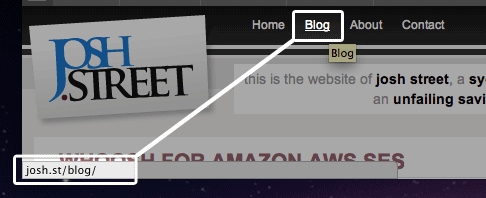Firefox 4 status bar
29 Mar 2011On running Firefox 4 for the first time I was shocked to mouseover a link and apparently not be able to see where I was going. Had they banished the status bar? Of course, everyone’s just playing catchup to Chrome’s UI, and its status bar isn’t really a bar at all – it just appears as and when it’s needed. Perfect.

The way it's meant to happen!
As and when typically just means “right before you click on a link”, with the whole thing triggered by mouseovers. The first page Firefox loads when you start the browser is available here – http://www.mozilla.com/en-US/firefox/4.0/firstrun/ – can you see what’s wrong with it?
I love event-listenery JavaScript as much as the next guy, but the icon on Step 2 suggested I’d be going to another page (c’mon, that’s just what right angle quotation marks have been co-opted to mean on the web!) while the browser wouldn’t say where.
Before visiting any actual pages in Firefox, not much trusting it at this point, I did some quick Googling and discovered two things:
- That you can bring back the status bar by simply typing ⌘ + / or Ctrl + /, and
- That, not knowing this, people have created at least one browser extension to do exactly that.
Fail.
Of course, if I’d bothered to actually USE Firefox for 2 minutes–trusting it even though it wouldn’t tell me where links were pointing–I’d have discovered that ordinarily it does. Pie-faced, I retreated to blogging angrily about how Mozilla’s first run screen is a great HTML5 page but a horrible initial demo of the browser’s capabilities.
A few observations from this:
- Browsers need to tell you where you’re going next. Users don’t[/shouldn’t] trust the Internet enough to find out when they arrive.
- None of this would’ve happened had the team creating the landing page used progressive enhancement and unobtrusive JS technique.
- The team probably didn’t because they wanted to show off how well their amazing browser does fancy “HTML5″ (in the Jobs-ian CSS/JS inclusive sense) stuff. Fine, but also link to a page that has the same content.
- Browser vendors are responsible for keeping user’s trust from the very start. This is a weird issue because it’s actually nothing to do with the browser’s functionality itself, but it temporarily impacted my opinion on how seriously Firefox take user choice/security/usability in a significant way.
- No-one actually uses Firefox anymore, so it doesn’t matter. It is a pain while using Firebug to test my own sites, though. ;-)